Detailed Report on UK Law and Legal Systems: Unit 7 Assessment
VerifiedAdded on 2023/01/13
|11
|3511
|61
Report
AI Summary
This report provides a detailed analysis of the English law and legal systems, focusing on both civil and criminal law procedures. It begins with an introduction to the structure of magistrates' and crown courts, including their roles and responsibilities within the UK legal framework. The report then critically examines the criminal justice system, outlining the processes of investigation, arrest, prosecution, arraignment, pretrial detention, plea bargaining, trial, sentencing, and appeals. It explores the structure of the courts, the handling of criminal offenses, and the appeal process, including the grounds and procedures for appeals. The report also investigates the types and principles of law that apply to particular offenses, enhancing the understanding of the laws and legal systems of the United Kingdom. The report covers the structure of magistrates' & Crown court in UK and also includes the appeal process and the manner in which it is exercised. This report will increase and enhance the understanding of the laws and legal systems of United Kingdom.
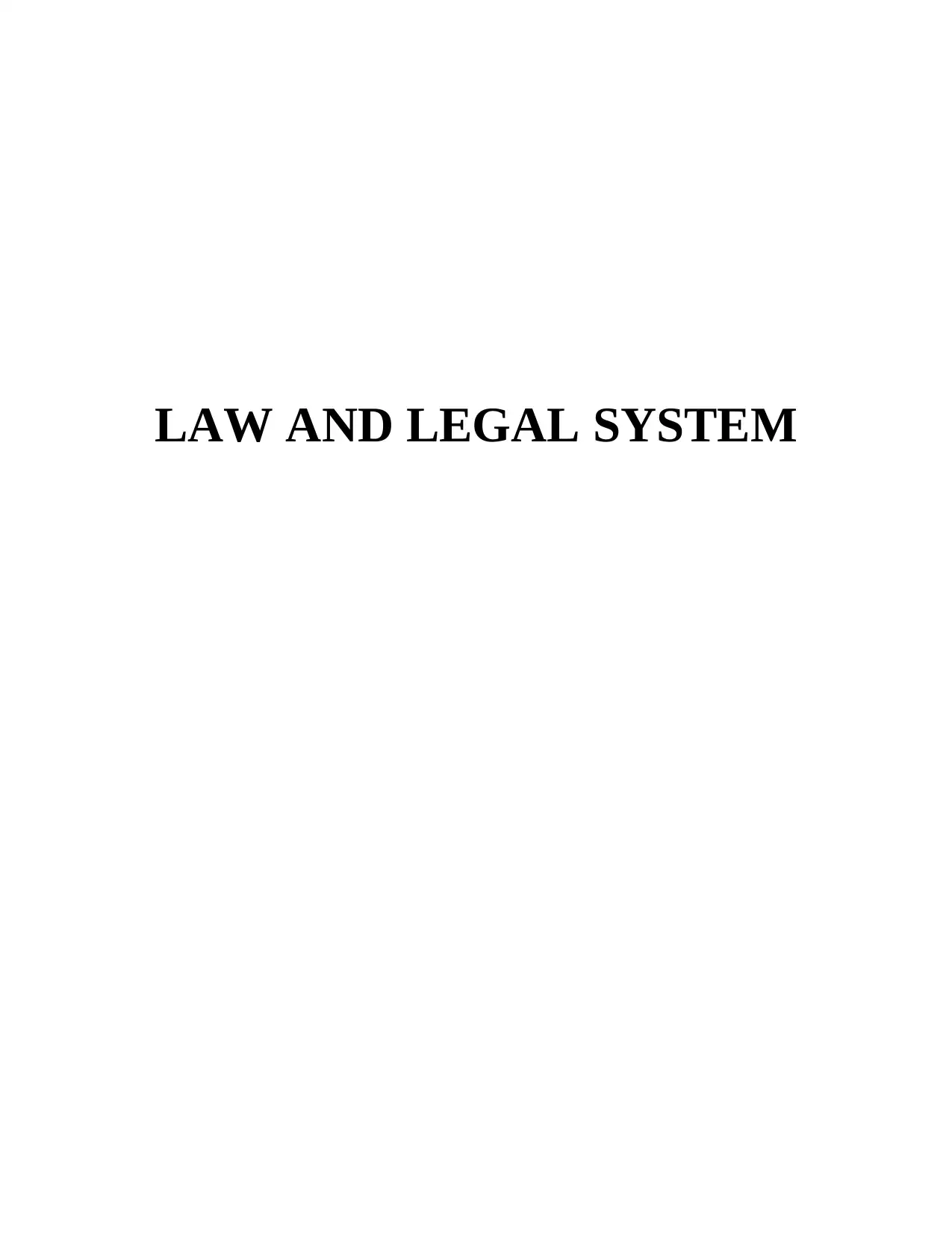
LAW AND LEGAL SYSTEM
Paraphrase This Document
Need a fresh take? Get an instant paraphrase of this document with our AI Paraphraser
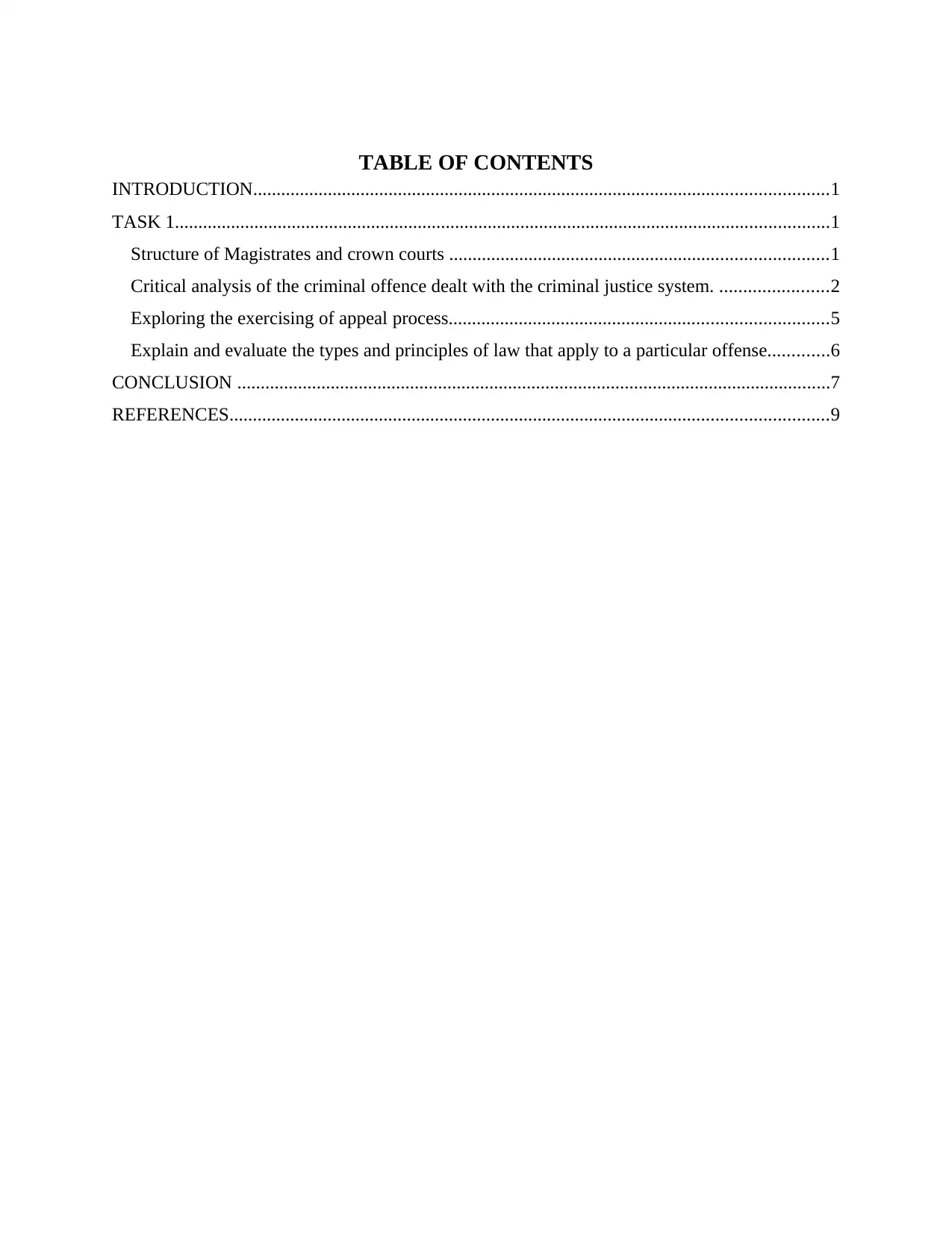
TABLE OF CONTENTS
INTRODUCTION...........................................................................................................................1
TASK 1............................................................................................................................................1
Structure of Magistrates and crown courts .................................................................................1
Critical analysis of the criminal offence dealt with the criminal justice system. .......................2
Exploring the exercising of appeal process.................................................................................5
Explain and evaluate the types and principles of law that apply to a particular offense.............6
CONCLUSION ...............................................................................................................................7
REFERENCES................................................................................................................................9
INTRODUCTION...........................................................................................................................1
TASK 1............................................................................................................................................1
Structure of Magistrates and crown courts .................................................................................1
Critical analysis of the criminal offence dealt with the criminal justice system. .......................2
Exploring the exercising of appeal process.................................................................................5
Explain and evaluate the types and principles of law that apply to a particular offense.............6
CONCLUSION ...............................................................................................................................7
REFERENCES................................................................................................................................9
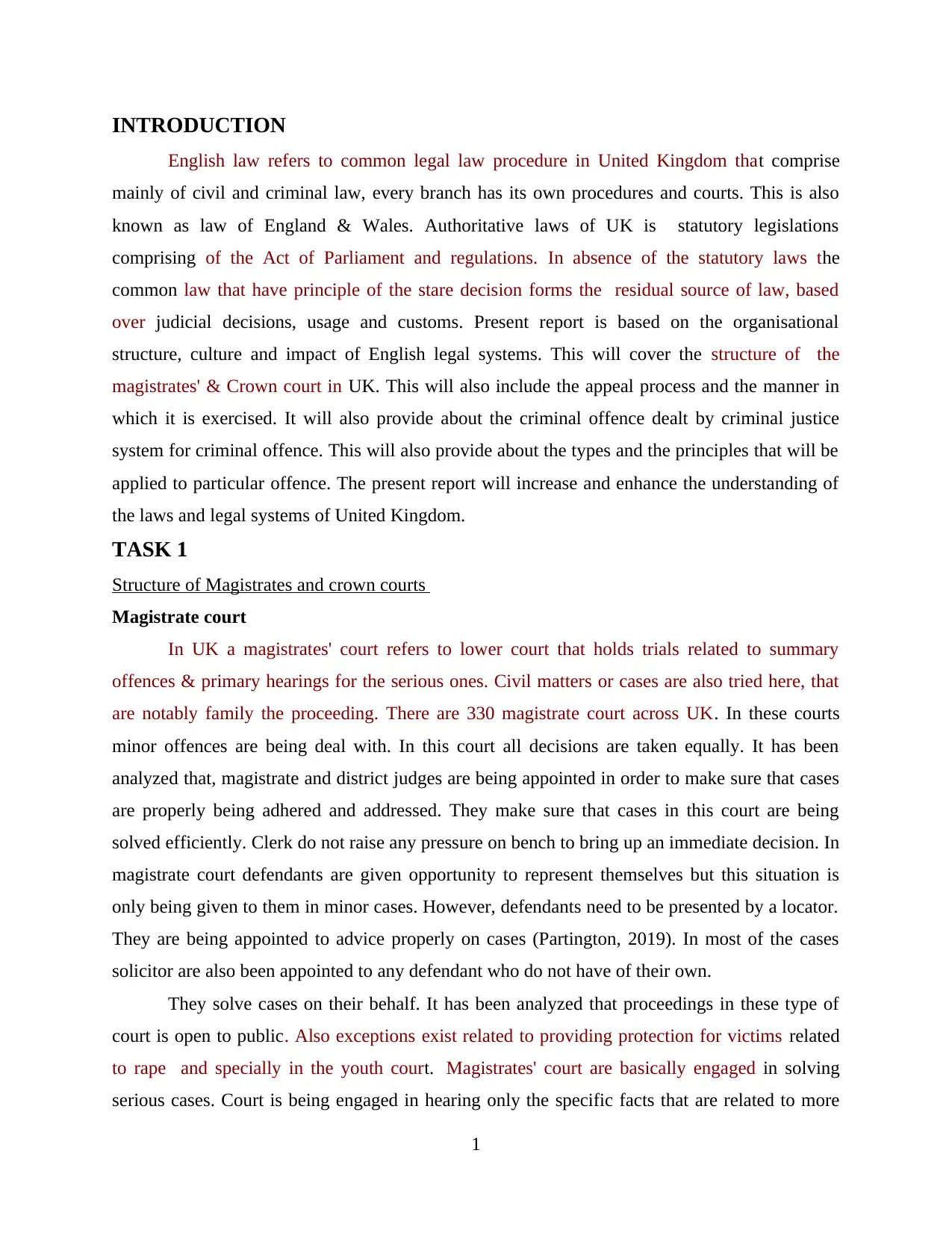
INTRODUCTION
English law refers to common legal law procedure in United Kingdom that comprise
mainly of civil and criminal law, every branch has its own procedures and courts. This is also
known as law of England & Wales. Authoritative laws of UK is statutory legislations
comprising of the Act of Parliament and regulations. In absence of the statutory laws the
common law that have principle of the stare decision forms the residual source of law, based
over judicial decisions, usage and customs. Present report is based on the organisational
structure, culture and impact of English legal systems. This will cover the structure of the
magistrates' & Crown court in UK. This will also include the appeal process and the manner in
which it is exercised. It will also provide about the criminal offence dealt by criminal justice
system for criminal offence. This will also provide about the types and the principles that will be
applied to particular offence. The present report will increase and enhance the understanding of
the laws and legal systems of United Kingdom.
TASK 1
Structure of Magistrates and crown courts
Magistrate court
In UK a magistrates' court refers to lower court that holds trials related to summary
offences & primary hearings for the serious ones. Civil matters or cases are also tried here, that
are notably family the proceeding. There are 330 magistrate court across UK. In these courts
minor offences are being deal with. In this court all decisions are taken equally. It has been
analyzed that, magistrate and district judges are being appointed in order to make sure that cases
are properly being adhered and addressed. They make sure that cases in this court are being
solved efficiently. Clerk do not raise any pressure on bench to bring up an immediate decision. In
magistrate court defendants are given opportunity to represent themselves but this situation is
only being given to them in minor cases. However, defendants need to be presented by a locator.
They are being appointed to advice properly on cases (Partington, 2019). In most of the cases
solicitor are also been appointed to any defendant who do not have of their own.
They solve cases on their behalf. It has been analyzed that proceedings in these type of
court is open to public. Also exceptions exist related to providing protection for victims related
to rape and specially in the youth court. Magistrates' court are basically engaged in solving
serious cases. Court is being engaged in hearing only the specific facts that are related to more
1
English law refers to common legal law procedure in United Kingdom that comprise
mainly of civil and criminal law, every branch has its own procedures and courts. This is also
known as law of England & Wales. Authoritative laws of UK is statutory legislations
comprising of the Act of Parliament and regulations. In absence of the statutory laws the
common law that have principle of the stare decision forms the residual source of law, based
over judicial decisions, usage and customs. Present report is based on the organisational
structure, culture and impact of English legal systems. This will cover the structure of the
magistrates' & Crown court in UK. This will also include the appeal process and the manner in
which it is exercised. It will also provide about the criminal offence dealt by criminal justice
system for criminal offence. This will also provide about the types and the principles that will be
applied to particular offence. The present report will increase and enhance the understanding of
the laws and legal systems of United Kingdom.
TASK 1
Structure of Magistrates and crown courts
Magistrate court
In UK a magistrates' court refers to lower court that holds trials related to summary
offences & primary hearings for the serious ones. Civil matters or cases are also tried here, that
are notably family the proceeding. There are 330 magistrate court across UK. In these courts
minor offences are being deal with. In this court all decisions are taken equally. It has been
analyzed that, magistrate and district judges are being appointed in order to make sure that cases
are properly being adhered and addressed. They make sure that cases in this court are being
solved efficiently. Clerk do not raise any pressure on bench to bring up an immediate decision. In
magistrate court defendants are given opportunity to represent themselves but this situation is
only being given to them in minor cases. However, defendants need to be presented by a locator.
They are being appointed to advice properly on cases (Partington, 2019). In most of the cases
solicitor are also been appointed to any defendant who do not have of their own.
They solve cases on their behalf. It has been analyzed that proceedings in these type of
court is open to public. Also exceptions exist related to providing protection for victims related
to rape and specially in the youth court. Magistrates' court are basically engaged in solving
serious cases. Court is being engaged in hearing only the specific facts that are related to more
1
⊘ This is a preview!⊘
Do you want full access?
Subscribe today to unlock all pages.

Trusted by 1+ million students worldwide
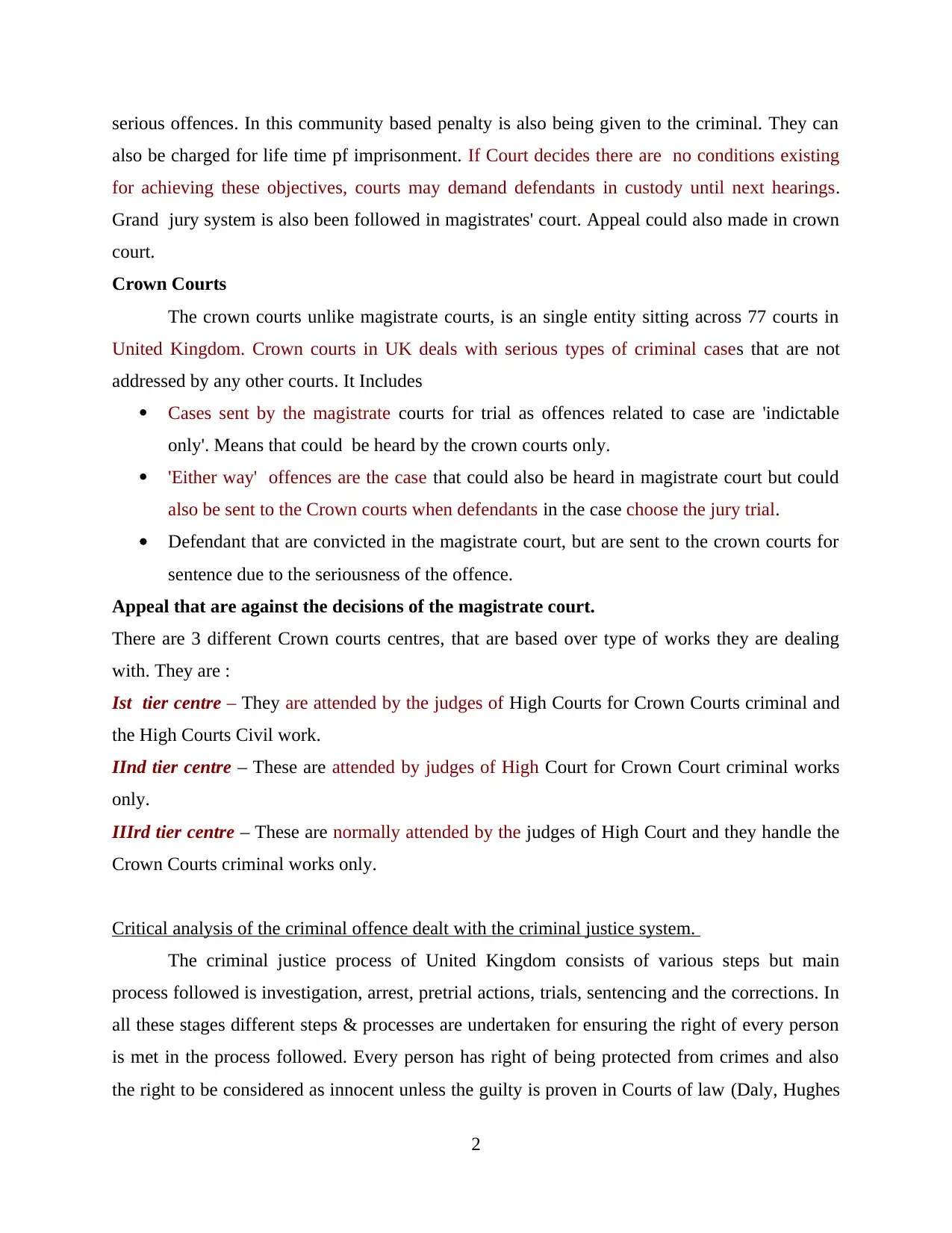
serious offences. In this community based penalty is also being given to the criminal. They can
also be charged for life time pf imprisonment. If Court decides there are no conditions existing
for achieving these objectives, courts may demand defendants in custody until next hearings.
Grand jury system is also been followed in magistrates' court. Appeal could also made in crown
court.
Crown Courts
The crown courts unlike magistrate courts, is an single entity sitting across 77 courts in
United Kingdom. Crown courts in UK deals with serious types of criminal cases that are not
addressed by any other courts. It Includes
Cases sent by the magistrate courts for trial as offences related to case are 'indictable
only'. Means that could be heard by the crown courts only.
'Either way' offences are the case that could also be heard in magistrate court but could
also be sent to the Crown courts when defendants in the case choose the jury trial.
Defendant that are convicted in the magistrate court, but are sent to the crown courts for
sentence due to the seriousness of the offence.
Appeal that are against the decisions of the magistrate court.
There are 3 different Crown courts centres, that are based over type of works they are dealing
with. They are :
Ist tier centre – They are attended by the judges of High Courts for Crown Courts criminal and
the High Courts Civil work.
IInd tier centre – These are attended by judges of High Court for Crown Court criminal works
only.
IIIrd tier centre – These are normally attended by the judges of High Court and they handle the
Crown Courts criminal works only.
Critical analysis of the criminal offence dealt with the criminal justice system.
The criminal justice process of United Kingdom consists of various steps but main
process followed is investigation, arrest, pretrial actions, trials, sentencing and the corrections. In
all these stages different steps & processes are undertaken for ensuring the right of every person
is met in the process followed. Every person has right of being protected from crimes and also
the right to be considered as innocent unless the guilty is proven in Courts of law (Daly, Hughes
2
also be charged for life time pf imprisonment. If Court decides there are no conditions existing
for achieving these objectives, courts may demand defendants in custody until next hearings.
Grand jury system is also been followed in magistrates' court. Appeal could also made in crown
court.
Crown Courts
The crown courts unlike magistrate courts, is an single entity sitting across 77 courts in
United Kingdom. Crown courts in UK deals with serious types of criminal cases that are not
addressed by any other courts. It Includes
Cases sent by the magistrate courts for trial as offences related to case are 'indictable
only'. Means that could be heard by the crown courts only.
'Either way' offences are the case that could also be heard in magistrate court but could
also be sent to the Crown courts when defendants in the case choose the jury trial.
Defendant that are convicted in the magistrate court, but are sent to the crown courts for
sentence due to the seriousness of the offence.
Appeal that are against the decisions of the magistrate court.
There are 3 different Crown courts centres, that are based over type of works they are dealing
with. They are :
Ist tier centre – They are attended by the judges of High Courts for Crown Courts criminal and
the High Courts Civil work.
IInd tier centre – These are attended by judges of High Court for Crown Court criminal works
only.
IIIrd tier centre – These are normally attended by the judges of High Court and they handle the
Crown Courts criminal works only.
Critical analysis of the criminal offence dealt with the criminal justice system.
The criminal justice process of United Kingdom consists of various steps but main
process followed is investigation, arrest, pretrial actions, trials, sentencing and the corrections. In
all these stages different steps & processes are undertaken for ensuring the right of every person
is met in the process followed. Every person has right of being protected from crimes and also
the right to be considered as innocent unless the guilty is proven in Courts of law (Daly, Hughes
2
Paraphrase This Document
Need a fresh take? Get an instant paraphrase of this document with our AI Paraphraser
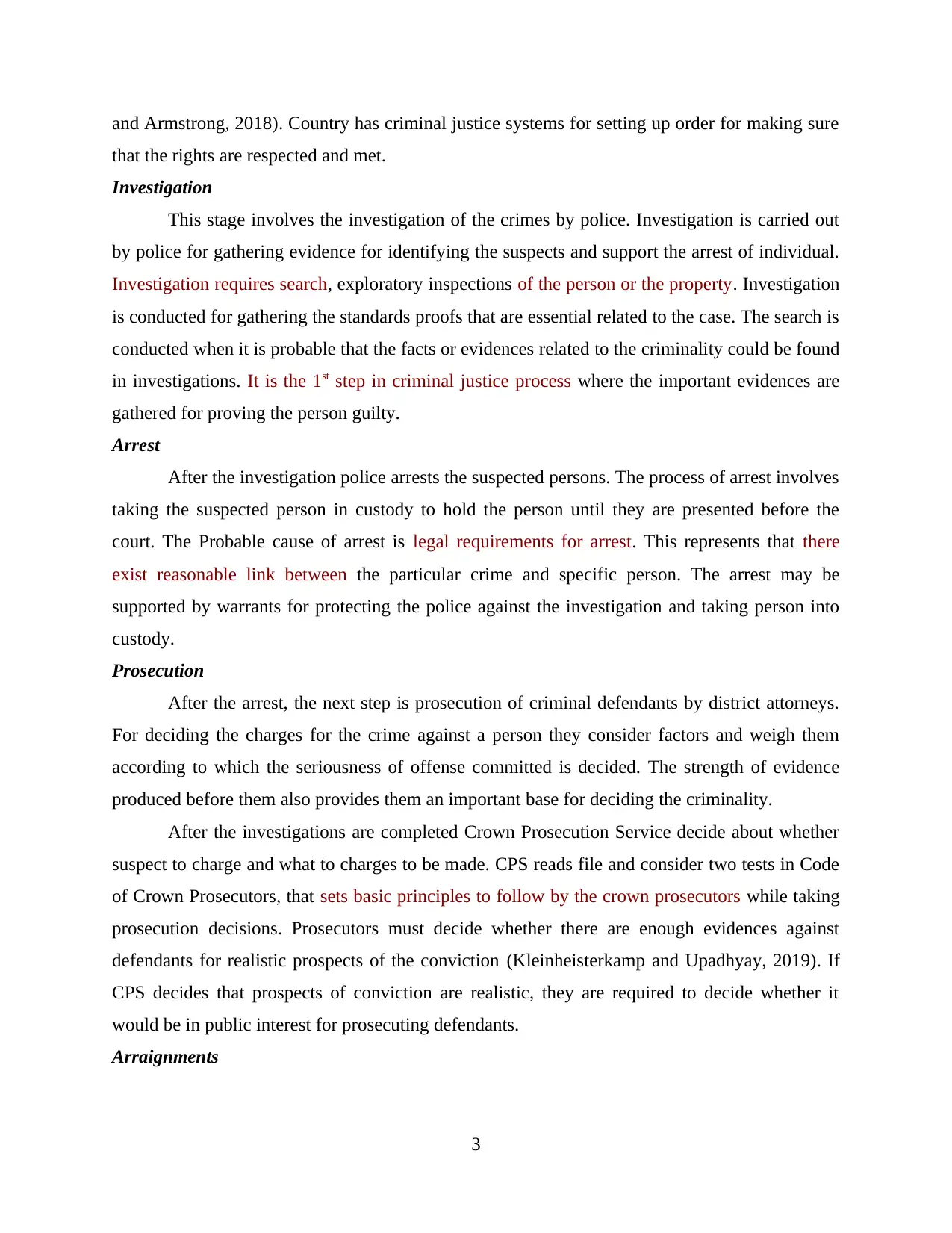
and Armstrong, 2018). Country has criminal justice systems for setting up order for making sure
that the rights are respected and met.
Investigation
This stage involves the investigation of the crimes by police. Investigation is carried out
by police for gathering evidence for identifying the suspects and support the arrest of individual.
Investigation requires search, exploratory inspections of the person or the property. Investigation
is conducted for gathering the standards proofs that are essential related to the case. The search is
conducted when it is probable that the facts or evidences related to the criminality could be found
in investigations. It is the 1st step in criminal justice process where the important evidences are
gathered for proving the person guilty.
Arrest
After the investigation police arrests the suspected persons. The process of arrest involves
taking the suspected person in custody to hold the person until they are presented before the
court. The Probable cause of arrest is legal requirements for arrest. This represents that there
exist reasonable link between the particular crime and specific person. The arrest may be
supported by warrants for protecting the police against the investigation and taking person into
custody.
Prosecution
After the arrest, the next step is prosecution of criminal defendants by district attorneys.
For deciding the charges for the crime against a person they consider factors and weigh them
according to which the seriousness of offense committed is decided. The strength of evidence
produced before them also provides them an important base for deciding the criminality.
After the investigations are completed Crown Prosecution Service decide about whether
suspect to charge and what to charges to be made. CPS reads file and consider two tests in Code
of Crown Prosecutors, that sets basic principles to follow by the crown prosecutors while taking
prosecution decisions. Prosecutors must decide whether there are enough evidences against
defendants for realistic prospects of the conviction (Kleinheisterkamp and Upadhyay, 2019). If
CPS decides that prospects of conviction are realistic, they are required to decide whether it
would be in public interest for prosecuting defendants.
Arraignments
3
that the rights are respected and met.
Investigation
This stage involves the investigation of the crimes by police. Investigation is carried out
by police for gathering evidence for identifying the suspects and support the arrest of individual.
Investigation requires search, exploratory inspections of the person or the property. Investigation
is conducted for gathering the standards proofs that are essential related to the case. The search is
conducted when it is probable that the facts or evidences related to the criminality could be found
in investigations. It is the 1st step in criminal justice process where the important evidences are
gathered for proving the person guilty.
Arrest
After the investigation police arrests the suspected persons. The process of arrest involves
taking the suspected person in custody to hold the person until they are presented before the
court. The Probable cause of arrest is legal requirements for arrest. This represents that there
exist reasonable link between the particular crime and specific person. The arrest may be
supported by warrants for protecting the police against the investigation and taking person into
custody.
Prosecution
After the arrest, the next step is prosecution of criminal defendants by district attorneys.
For deciding the charges for the crime against a person they consider factors and weigh them
according to which the seriousness of offense committed is decided. The strength of evidence
produced before them also provides them an important base for deciding the criminality.
After the investigations are completed Crown Prosecution Service decide about whether
suspect to charge and what to charges to be made. CPS reads file and consider two tests in Code
of Crown Prosecutors, that sets basic principles to follow by the crown prosecutors while taking
prosecution decisions. Prosecutors must decide whether there are enough evidences against
defendants for realistic prospects of the conviction (Kleinheisterkamp and Upadhyay, 2019). If
CPS decides that prospects of conviction are realistic, they are required to decide whether it
would be in public interest for prosecuting defendants.
Arraignments
3
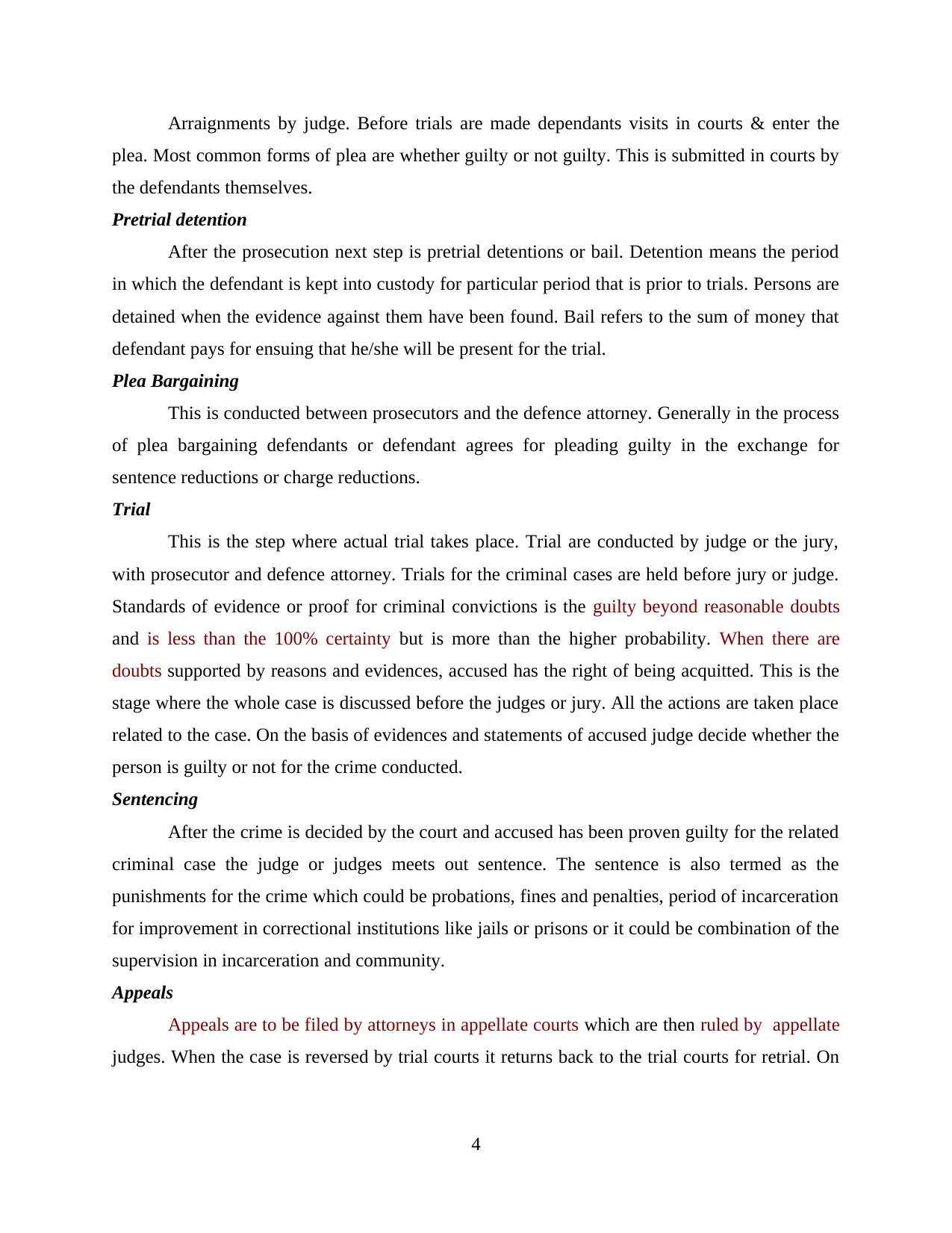
Arraignments by judge. Before trials are made dependants visits in courts & enter the
plea. Most common forms of plea are whether guilty or not guilty. This is submitted in courts by
the defendants themselves.
Pretrial detention
After the prosecution next step is pretrial detentions or bail. Detention means the period
in which the defendant is kept into custody for particular period that is prior to trials. Persons are
detained when the evidence against them have been found. Bail refers to the sum of money that
defendant pays for ensuing that he/she will be present for the trial.
Plea Bargaining
This is conducted between prosecutors and the defence attorney. Generally in the process
of plea bargaining defendants or defendant agrees for pleading guilty in the exchange for
sentence reductions or charge reductions.
Trial
This is the step where actual trial takes place. Trial are conducted by judge or the jury,
with prosecutor and defence attorney. Trials for the criminal cases are held before jury or judge.
Standards of evidence or proof for criminal convictions is the guilty beyond reasonable doubts
and is less than the 100% certainty but is more than the higher probability. When there are
doubts supported by reasons and evidences, accused has the right of being acquitted. This is the
stage where the whole case is discussed before the judges or jury. All the actions are taken place
related to the case. On the basis of evidences and statements of accused judge decide whether the
person is guilty or not for the crime conducted.
Sentencing
After the crime is decided by the court and accused has been proven guilty for the related
criminal case the judge or judges meets out sentence. The sentence is also termed as the
punishments for the crime which could be probations, fines and penalties, period of incarceration
for improvement in correctional institutions like jails or prisons or it could be combination of the
supervision in incarceration and community.
Appeals
Appeals are to be filed by attorneys in appellate courts which are then ruled by appellate
judges. When the case is reversed by trial courts it returns back to the trial courts for retrial. On
4
plea. Most common forms of plea are whether guilty or not guilty. This is submitted in courts by
the defendants themselves.
Pretrial detention
After the prosecution next step is pretrial detentions or bail. Detention means the period
in which the defendant is kept into custody for particular period that is prior to trials. Persons are
detained when the evidence against them have been found. Bail refers to the sum of money that
defendant pays for ensuing that he/she will be present for the trial.
Plea Bargaining
This is conducted between prosecutors and the defence attorney. Generally in the process
of plea bargaining defendants or defendant agrees for pleading guilty in the exchange for
sentence reductions or charge reductions.
Trial
This is the step where actual trial takes place. Trial are conducted by judge or the jury,
with prosecutor and defence attorney. Trials for the criminal cases are held before jury or judge.
Standards of evidence or proof for criminal convictions is the guilty beyond reasonable doubts
and is less than the 100% certainty but is more than the higher probability. When there are
doubts supported by reasons and evidences, accused has the right of being acquitted. This is the
stage where the whole case is discussed before the judges or jury. All the actions are taken place
related to the case. On the basis of evidences and statements of accused judge decide whether the
person is guilty or not for the crime conducted.
Sentencing
After the crime is decided by the court and accused has been proven guilty for the related
criminal case the judge or judges meets out sentence. The sentence is also termed as the
punishments for the crime which could be probations, fines and penalties, period of incarceration
for improvement in correctional institutions like jails or prisons or it could be combination of the
supervision in incarceration and community.
Appeals
Appeals are to be filed by attorneys in appellate courts which are then ruled by appellate
judges. When the case is reversed by trial courts it returns back to the trial courts for retrial. On
4
⊘ This is a preview!⊘
Do you want full access?
Subscribe today to unlock all pages.

Trusted by 1+ million students worldwide
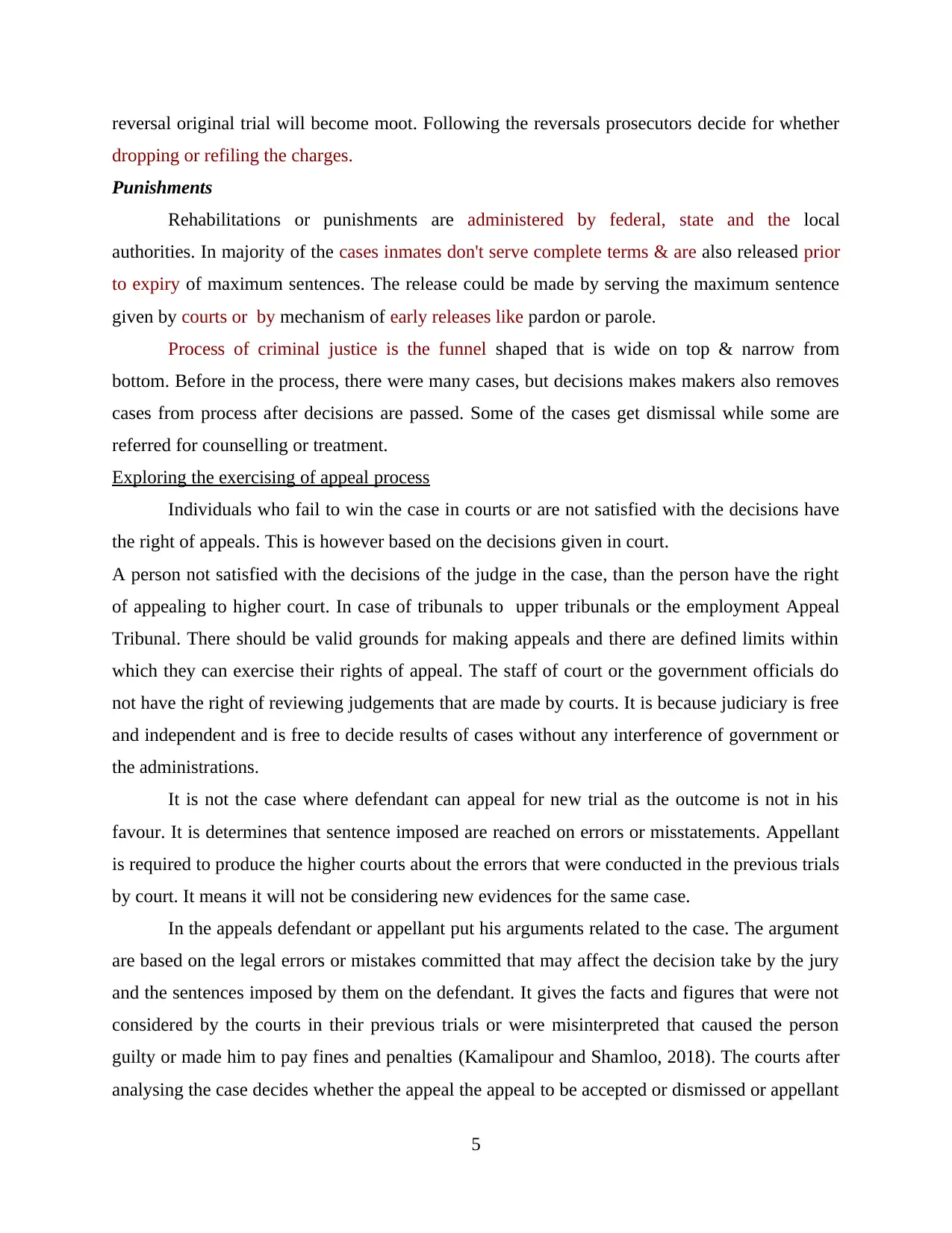
reversal original trial will become moot. Following the reversals prosecutors decide for whether
dropping or refiling the charges.
Punishments
Rehabilitations or punishments are administered by federal, state and the local
authorities. In majority of the cases inmates don't serve complete terms & are also released prior
to expiry of maximum sentences. The release could be made by serving the maximum sentence
given by courts or by mechanism of early releases like pardon or parole.
Process of criminal justice is the funnel shaped that is wide on top & narrow from
bottom. Before in the process, there were many cases, but decisions makes makers also removes
cases from process after decisions are passed. Some of the cases get dismissal while some are
referred for counselling or treatment.
Exploring the exercising of appeal process
Individuals who fail to win the case in courts or are not satisfied with the decisions have
the right of appeals. This is however based on the decisions given in court.
A person not satisfied with the decisions of the judge in the case, than the person have the right
of appealing to higher court. In case of tribunals to upper tribunals or the employment Appeal
Tribunal. There should be valid grounds for making appeals and there are defined limits within
which they can exercise their rights of appeal. The staff of court or the government officials do
not have the right of reviewing judgements that are made by courts. It is because judiciary is free
and independent and is free to decide results of cases without any interference of government or
the administrations.
It is not the case where defendant can appeal for new trial as the outcome is not in his
favour. It is determines that sentence imposed are reached on errors or misstatements. Appellant
is required to produce the higher courts about the errors that were conducted in the previous trials
by court. It means it will not be considering new evidences for the same case.
In the appeals defendant or appellant put his arguments related to the case. The argument
are based on the legal errors or mistakes committed that may affect the decision take by the jury
and the sentences imposed by them on the defendant. It gives the facts and figures that were not
considered by the courts in their previous trials or were misinterpreted that caused the person
guilty or made him to pay fines and penalties (Kamalipour and Shamloo, 2018). The courts after
analysing the case decides whether the appeal the appeal to be accepted or dismissed or appellant
5
dropping or refiling the charges.
Punishments
Rehabilitations or punishments are administered by federal, state and the local
authorities. In majority of the cases inmates don't serve complete terms & are also released prior
to expiry of maximum sentences. The release could be made by serving the maximum sentence
given by courts or by mechanism of early releases like pardon or parole.
Process of criminal justice is the funnel shaped that is wide on top & narrow from
bottom. Before in the process, there were many cases, but decisions makes makers also removes
cases from process after decisions are passed. Some of the cases get dismissal while some are
referred for counselling or treatment.
Exploring the exercising of appeal process
Individuals who fail to win the case in courts or are not satisfied with the decisions have
the right of appeals. This is however based on the decisions given in court.
A person not satisfied with the decisions of the judge in the case, than the person have the right
of appealing to higher court. In case of tribunals to upper tribunals or the employment Appeal
Tribunal. There should be valid grounds for making appeals and there are defined limits within
which they can exercise their rights of appeal. The staff of court or the government officials do
not have the right of reviewing judgements that are made by courts. It is because judiciary is free
and independent and is free to decide results of cases without any interference of government or
the administrations.
It is not the case where defendant can appeal for new trial as the outcome is not in his
favour. It is determines that sentence imposed are reached on errors or misstatements. Appellant
is required to produce the higher courts about the errors that were conducted in the previous trials
by court. It means it will not be considering new evidences for the same case.
In the appeals defendant or appellant put his arguments related to the case. The argument
are based on the legal errors or mistakes committed that may affect the decision take by the jury
and the sentences imposed by them on the defendant. It gives the facts and figures that were not
considered by the courts in their previous trials or were misinterpreted that caused the person
guilty or made him to pay fines and penalties (Kamalipour and Shamloo, 2018). The courts after
analysing the case decides whether the appeal the appeal to be accepted or dismissed or appellant
5
Paraphrase This Document
Need a fresh take? Get an instant paraphrase of this document with our AI Paraphraser

will be re-tried or will be re-sentenced. While exercising appeals, court that review case looks at
record only of proceedings carried out in lower court and the new evidences are not considered.
Record is made by reporter of the court in transcripts about everything that was said in court by
the judges, witnesses and attorneys. Anything that is admitted in addition to the evidence like
objects or documents, it will also become part of records.
The appeals are exercised as a new case and all the cases that are tried in the previous
courts can only be applied for appeals. It is exercised as a new case by the higher courts from the
beginning. Judges of the court review all the proofs and evidence that are gathered by the the
police on investigation and search. Whole of the process is exercised in the same manner as that
in previous case. The appeal process is right available to the people for getting right justice. The
errors and mistakes conveyed by the court are considered and are reviewed back by the courts.
This helps the individuals in getting right justice as the courts reviews the all evidences
produced before the courts. On the basis of it provides the people are saved from suffering the
sentence that are given on prior misstated evidences. There are chances that the courts may
commit errors or mistakes on the basis of evidences as the law may be interpreted wrongly by
the judge or jury. There may be cases that the evidenced are misstated or moulded by the
attorneys for proving the defendants innocent (Hertogh and Kurkchiyan, 2016). Appeals
provides the opportunity for getting justice if the lower courts have not given right judgements or
have made errors or mistakes on legal grounds as this may affect the life of person accused of
crime.
Explain and evaluate the types & principles regarding law which applies to specific offense.
Several laws and principles that applies to a specific offense that are as follows-
Criminal law- It is stated as the statutory rules of the law that reveals the criminal
offense, regulating apprehension, test of the questionable persons, charging and fixing penalties
or medium of treatment that are applicable to the convicted offenders (Petersen, 2020). It is
referred as the only device through which an organized societies protecting security of an
individual interest and in ensuring survival of a group.
Criminal law Principles- A traditional approach to a criminal law has been seen that the
crime is considered as an act which is depicted as morally wrong. The main objective of criminal
sanction is to make an offender giving a redistribution for the harm done and expiate his or her
moral guilt under which punishment was to met out in part to guilt of an accused.
6
record only of proceedings carried out in lower court and the new evidences are not considered.
Record is made by reporter of the court in transcripts about everything that was said in court by
the judges, witnesses and attorneys. Anything that is admitted in addition to the evidence like
objects or documents, it will also become part of records.
The appeals are exercised as a new case and all the cases that are tried in the previous
courts can only be applied for appeals. It is exercised as a new case by the higher courts from the
beginning. Judges of the court review all the proofs and evidence that are gathered by the the
police on investigation and search. Whole of the process is exercised in the same manner as that
in previous case. The appeal process is right available to the people for getting right justice. The
errors and mistakes conveyed by the court are considered and are reviewed back by the courts.
This helps the individuals in getting right justice as the courts reviews the all evidences
produced before the courts. On the basis of it provides the people are saved from suffering the
sentence that are given on prior misstated evidences. There are chances that the courts may
commit errors or mistakes on the basis of evidences as the law may be interpreted wrongly by
the judge or jury. There may be cases that the evidenced are misstated or moulded by the
attorneys for proving the defendants innocent (Hertogh and Kurkchiyan, 2016). Appeals
provides the opportunity for getting justice if the lower courts have not given right judgements or
have made errors or mistakes on legal grounds as this may affect the life of person accused of
crime.
Explain and evaluate the types & principles regarding law which applies to specific offense.
Several laws and principles that applies to a specific offense that are as follows-
Criminal law- It is stated as the statutory rules of the law that reveals the criminal
offense, regulating apprehension, test of the questionable persons, charging and fixing penalties
or medium of treatment that are applicable to the convicted offenders (Petersen, 2020). It is
referred as the only device through which an organized societies protecting security of an
individual interest and in ensuring survival of a group.
Criminal law Principles- A traditional approach to a criminal law has been seen that the
crime is considered as an act which is depicted as morally wrong. The main objective of criminal
sanction is to make an offender giving a redistribution for the harm done and expiate his or her
moral guilt under which punishment was to met out in part to guilt of an accused.
6
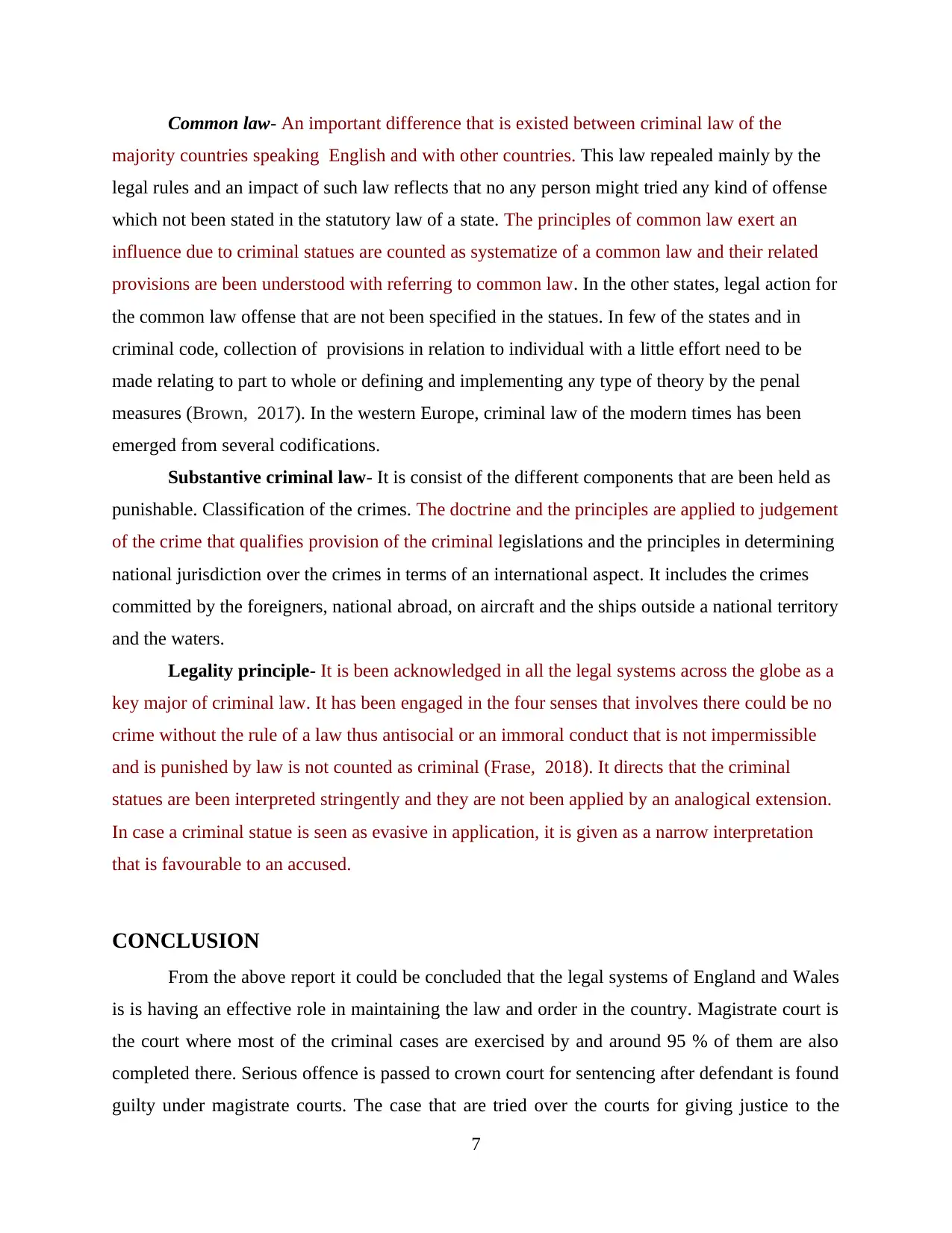
Common law- An important difference that is existed between criminal law of the
majority countries speaking English and with other countries. This law repealed mainly by the
legal rules and an impact of such law reflects that no any person might tried any kind of offense
which not been stated in the statutory law of a state. The principles of common law exert an
influence due to criminal statues are counted as systematize of a common law and their related
provisions are been understood with referring to common law. In the other states, legal action for
the common law offense that are not been specified in the statues. In few of the states and in
criminal code, collection of provisions in relation to individual with a little effort need to be
made relating to part to whole or defining and implementing any type of theory by the penal
measures (Brown, 2017). In the western Europe, criminal law of the modern times has been
emerged from several codifications.
Substantive criminal law- It is consist of the different components that are been held as
punishable. Classification of the crimes. The doctrine and the principles are applied to judgement
of the crime that qualifies provision of the criminal legislations and the principles in determining
national jurisdiction over the crimes in terms of an international aspect. It includes the crimes
committed by the foreigners, national abroad, on aircraft and the ships outside a national territory
and the waters.
Legality principle- It is been acknowledged in all the legal systems across the globe as a
key major of criminal law. It has been engaged in the four senses that involves there could be no
crime without the rule of a law thus antisocial or an immoral conduct that is not impermissible
and is punished by law is not counted as criminal (Frase, 2018). It directs that the criminal
statues are been interpreted stringently and they are not been applied by an analogical extension.
In case a criminal statue is seen as evasive in application, it is given as a narrow interpretation
that is favourable to an accused.
CONCLUSION
From the above report it could be concluded that the legal systems of England and Wales
is is having an effective role in maintaining the law and order in the country. Magistrate court is
the court where most of the criminal cases are exercised by and around 95 % of them are also
completed there. Serious offence is passed to crown court for sentencing after defendant is found
guilty under magistrate courts. The case that are tried over the courts for giving justice to the
7
majority countries speaking English and with other countries. This law repealed mainly by the
legal rules and an impact of such law reflects that no any person might tried any kind of offense
which not been stated in the statutory law of a state. The principles of common law exert an
influence due to criminal statues are counted as systematize of a common law and their related
provisions are been understood with referring to common law. In the other states, legal action for
the common law offense that are not been specified in the statues. In few of the states and in
criminal code, collection of provisions in relation to individual with a little effort need to be
made relating to part to whole or defining and implementing any type of theory by the penal
measures (Brown, 2017). In the western Europe, criminal law of the modern times has been
emerged from several codifications.
Substantive criminal law- It is consist of the different components that are been held as
punishable. Classification of the crimes. The doctrine and the principles are applied to judgement
of the crime that qualifies provision of the criminal legislations and the principles in determining
national jurisdiction over the crimes in terms of an international aspect. It includes the crimes
committed by the foreigners, national abroad, on aircraft and the ships outside a national territory
and the waters.
Legality principle- It is been acknowledged in all the legal systems across the globe as a
key major of criminal law. It has been engaged in the four senses that involves there could be no
crime without the rule of a law thus antisocial or an immoral conduct that is not impermissible
and is punished by law is not counted as criminal (Frase, 2018). It directs that the criminal
statues are been interpreted stringently and they are not been applied by an analogical extension.
In case a criminal statue is seen as evasive in application, it is given as a narrow interpretation
that is favourable to an accused.
CONCLUSION
From the above report it could be concluded that the legal systems of England and Wales
is is having an effective role in maintaining the law and order in the country. Magistrate court is
the court where most of the criminal cases are exercised by and around 95 % of them are also
completed there. Serious offence is passed to crown court for sentencing after defendant is found
guilty under magistrate courts. The case that are tried over the courts for giving justice to the
7
⊘ This is a preview!⊘
Do you want full access?
Subscribe today to unlock all pages.

Trusted by 1+ million students worldwide
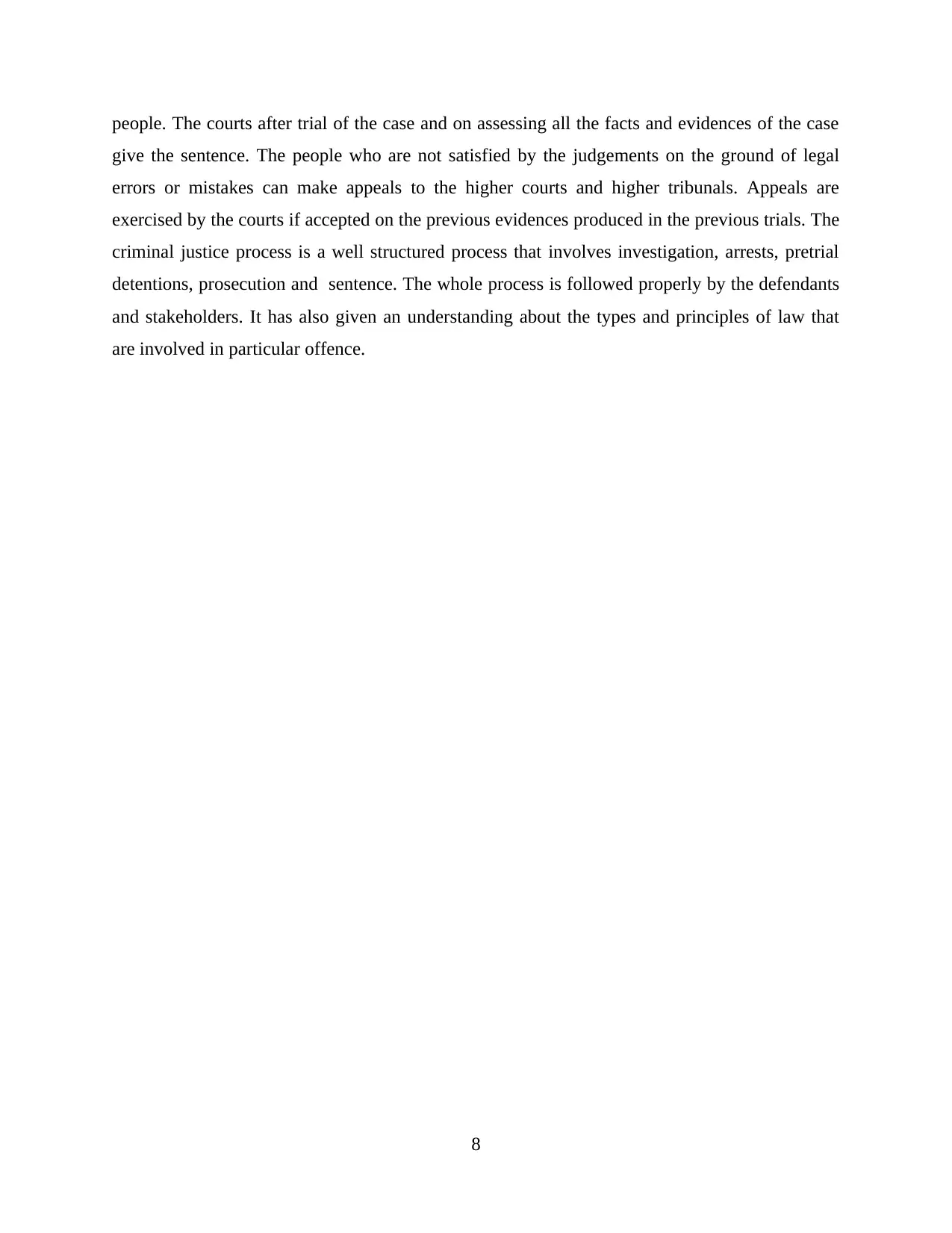
people. The courts after trial of the case and on assessing all the facts and evidences of the case
give the sentence. The people who are not satisfied by the judgements on the ground of legal
errors or mistakes can make appeals to the higher courts and higher tribunals. Appeals are
exercised by the courts if accepted on the previous evidences produced in the previous trials. The
criminal justice process is a well structured process that involves investigation, arrests, pretrial
detentions, prosecution and sentence. The whole process is followed properly by the defendants
and stakeholders. It has also given an understanding about the types and principles of law that
are involved in particular offence.
8
give the sentence. The people who are not satisfied by the judgements on the ground of legal
errors or mistakes can make appeals to the higher courts and higher tribunals. Appeals are
exercised by the courts if accepted on the previous evidences produced in the previous trials. The
criminal justice process is a well structured process that involves investigation, arrests, pretrial
detentions, prosecution and sentence. The whole process is followed properly by the defendants
and stakeholders. It has also given an understanding about the types and principles of law that
are involved in particular offence.
8
Paraphrase This Document
Need a fresh take? Get an instant paraphrase of this document with our AI Paraphraser

REFERENCES
Books and Journals
Brown, D. K., 2017. How Criminal Law Dictates Rules of Criminal Procedure. Rutgers UL
Rev. 70. p.1093.
Daly, P., Hughes, K. and Armstrong, K., 2018. Brexit and EU Nationals: Options for
Implementation in UK Law. University of Cambridge Faculty of Law Research Paper.
(1).
Frase, R. S., 2018. Principles and Procedures for Sentencing of Multiple Current
Offenses. Sentencing Multiple Crimes, pp.189-210.
Hertogh, M. and Kurkchiyan, M., 2016. ‘When politics comes into play, law is no longer law’:
images of collective legal consciousness in the UK, Poland and Bulgaria. International
Journal of Law in Context.12(4).pp.404-419.
Kamalipour, Y. and Shamloo, B., 2018. Pathology of The Psychedelic Drug and Narcotic-
Related Crimes in The Law of Iran and The United Kingdom. Iranian journal of
educational sociology.1(10). pp.150-160.
Kleinheisterkamp, J. and Upadhyay, S., 2019. The UK Supreme Court and International
Commercial Arbitration. b-Arbitra| Belgian Review of Arbitration.2019(2).pp.501-520.
Partington, M., 2019. Introduction to the English Legal System 2019-2020. Oxford University
Press, USA.
Petersen, T. S., 2020. No Offense! On the Offense Principle and Some New Challenges. In Why
Criminalize? (pp. 43-56). Springer, Cham.
9
Books and Journals
Brown, D. K., 2017. How Criminal Law Dictates Rules of Criminal Procedure. Rutgers UL
Rev. 70. p.1093.
Daly, P., Hughes, K. and Armstrong, K., 2018. Brexit and EU Nationals: Options for
Implementation in UK Law. University of Cambridge Faculty of Law Research Paper.
(1).
Frase, R. S., 2018. Principles and Procedures for Sentencing of Multiple Current
Offenses. Sentencing Multiple Crimes, pp.189-210.
Hertogh, M. and Kurkchiyan, M., 2016. ‘When politics comes into play, law is no longer law’:
images of collective legal consciousness in the UK, Poland and Bulgaria. International
Journal of Law in Context.12(4).pp.404-419.
Kamalipour, Y. and Shamloo, B., 2018. Pathology of The Psychedelic Drug and Narcotic-
Related Crimes in The Law of Iran and The United Kingdom. Iranian journal of
educational sociology.1(10). pp.150-160.
Kleinheisterkamp, J. and Upadhyay, S., 2019. The UK Supreme Court and International
Commercial Arbitration. b-Arbitra| Belgian Review of Arbitration.2019(2).pp.501-520.
Partington, M., 2019. Introduction to the English Legal System 2019-2020. Oxford University
Press, USA.
Petersen, T. S., 2020. No Offense! On the Offense Principle and Some New Challenges. In Why
Criminalize? (pp. 43-56). Springer, Cham.
9
1 out of 11
Related Documents
Your All-in-One AI-Powered Toolkit for Academic Success.
+13062052269
info@desklib.com
Available 24*7 on WhatsApp / Email
![[object Object]](/_next/static/media/star-bottom.7253800d.svg)
Unlock your academic potential
Copyright © 2020–2025 A2Z Services. All Rights Reserved. Developed and managed by ZUCOL.





